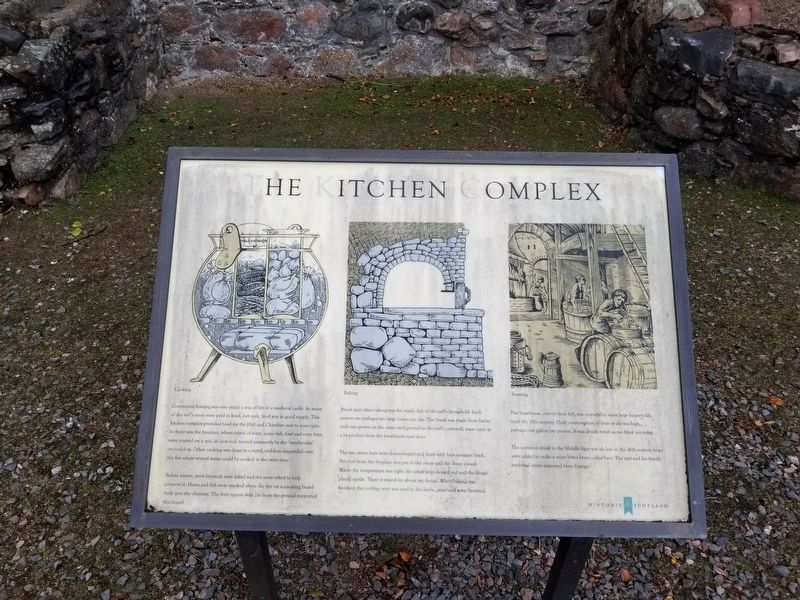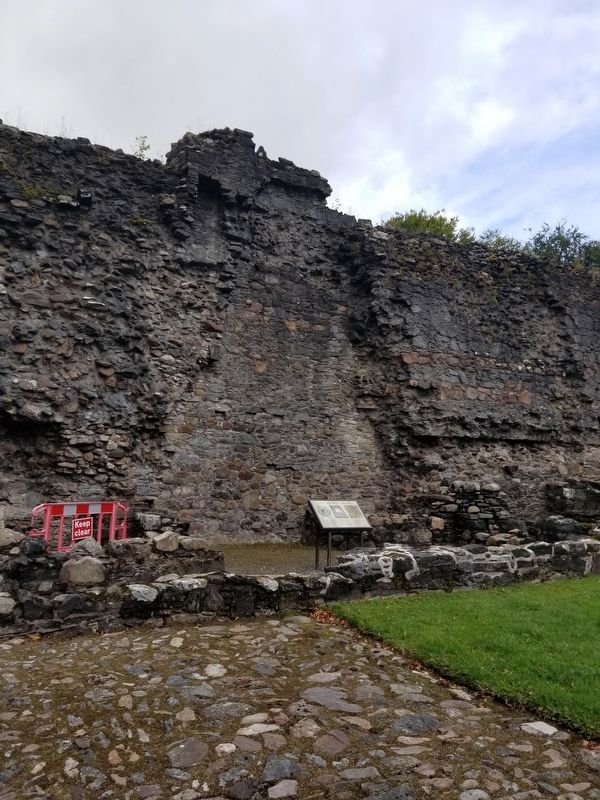Keith in Moray, Scotland, United Kingdom — Northwestern Europe (the British Isles)
The Kitchen Complex
Communal feasting was very much a way of life in a medieval castle. As many of the earl's rents were paid in kind, not cash, food was in good supply. This kitchen complex provided food for the Hall and Chamber over to your right. In front was the fireplace, where joints of meat, some fish, fowl and even fruit, were roasted on a spit, an iron rod, turned constantly by the ‘turnbrochie' or cook-boy. Other cooking was done in a metal cauldron suspended over the fire where several items could be cooked at the same time.
Before winter, most livestock were killed and the meat salted to help preserve it. Hams and fish were smoked above the fire on a smoking board built into the chimney. The four square slots 2m from the ground supported this board.
Baking
Bread and other baking was the staple diet of the earl's household. Each person ate perhaps two large loaves per day. The bread was made from barley and oats grown on the estate and ground in the earl's cornmill; yeast came as a by-product from the brewhouse next door.
The two ovens here were dome-shaped and lined with heat-resistant brick Hot fuel from the fireplace was put in the ovens and the doors closed. When the temperature was right, the ashes were cleared out and the dough placed inside. There it stayed for about two hours. When baking was finished, the cooling oven was used to dry herbs, grain and even firewood.
Brewing
The brewhouse, over to your left, was essential to most large households until the 19th century. Daily consumption of beer or ale was high, perhaps one gallon per person. It was drunk much as we drink tea today.
The common drink in the Middle Ages was ale but in the l6th century hops were added to make a more bitter brew, called beer. The earl and his family preferred wines imported from Europe.
Topics. This historical marker is listed in this topic list: Forts and Castles.
Location. 57° 27.205′ N, 3° 7.484′ W. Marker is in Keith, Scotland, in Moray. Marker can be reached from the intersection of Station Road and Castle Road, on the left when traveling south. Located at Balvenie Castle. Touch for map. Marker is in this post office area: Keith, Scotland AB55 4DH, United Kingdom. Touch for directions.
Other nearby markers. At least 8 other markers are within 14 kilometers of this marker, measured as the crow flies. The Earl of Atholl’s Lodging (within shouting distance of this marker); Balvenie Castle (within shouting distance of this marker); Yew Tree (approx. 0.3 kilometers away); Mortlach Parish War Memorial (approx. half a kilometer away); Alex William George (approx. one kilometer away); George Stephen (approx. one kilometer away); Dufftown Clock (approx. one kilometer away); Gordon Highlanders Memorial (approx. 14.4 kilometers away). Touch for a list and map of all markers in Keith.
Also see . . .
1. Visit Scotland - Balvenie Castle. (Submitted on January 4, 2019, by Michael Herrick of Southbury, Connecticut.)
2. Balvenie Castle on Wikipedia. (Submitted on January 4, 2019, by Michael Herrick of Southbury, Connecticut.)
Credits. This page was last revised on January 27, 2022. It was originally submitted on January 4, 2019, by Michael Herrick of Southbury, Connecticut. This page has been viewed 150 times since then and 3 times this year. Photos: 1, 2, 3. submitted on January 4, 2019, by Michael Herrick of Southbury, Connecticut.


